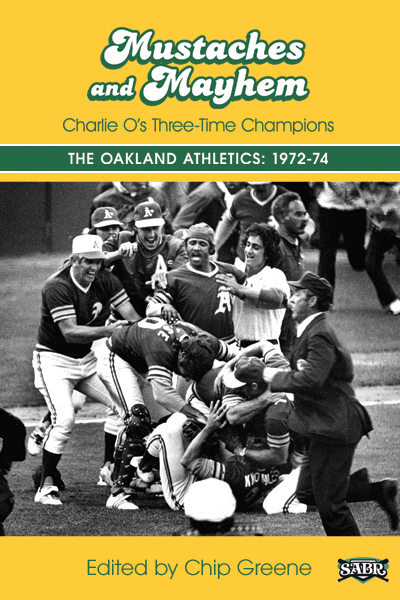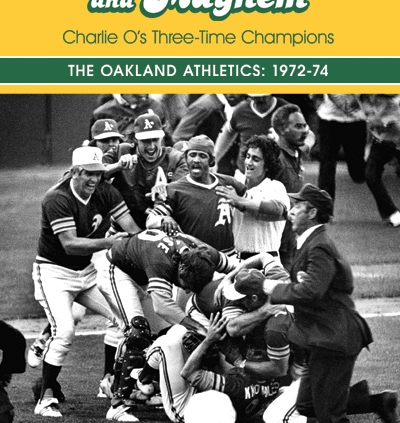Building a Champion: Charlie Finley and the Core of the Oakland A’s Championship Teams
This article was written by Nelson ‘Chip’ Greene
This article was published in 1972-74 Oakland Athletics essays
 “Equal parts carnival barker, professional bully, world-class tightwad, and uncanny builder of championship baseball teams, Oakland A’s owner Charlie Finley left a stamp on baseball that can still be seen more than 30 years after his departure from the game.”1 So wrote reviewer Alan Moores for the magazine Booklist in his 2010 review of G. Michael Green and Roger D. Launius’s excellent book, Charlie Finley, The Outrageous Story of Baseball’s Super Showman.2
“Equal parts carnival barker, professional bully, world-class tightwad, and uncanny builder of championship baseball teams, Oakland A’s owner Charlie Finley left a stamp on baseball that can still be seen more than 30 years after his departure from the game.”1 So wrote reviewer Alan Moores for the magazine Booklist in his 2010 review of G. Michael Green and Roger D. Launius’s excellent book, Charlie Finley, The Outrageous Story of Baseball’s Super Showman.2
Indeed, Finley was a man of great complexity. If he was “a skinflint who alienated players and fans”3 alike, so too was he a brilliant showman who introduced to the game such concepts as designated hitters and designated runners, orange baseballs, and night games in the World Series. Likewise, if Finley was “a loud-mouth, a tyrant and a miser,”4 he was also, in the words of author Launius, a man of “ingenious mind” who “often demonstrated innovation and vision between his bullshit.”5
Of such cantankerous and creative personalities are legends often made.
Yet, if Finley’s legacy is largely that of an ornery cuss who feuded alike with baseball’s powers that be and his own players, and a man who “professed indifference to the often savage bickering among his players and to their contempt for him,”6 it’s easy to overlook his most brilliant and lasting accomplishment: For when the ranting, the raving, and the vitriol from both sides subsided, Finley could “point to three straight world championships as an acceptable trade-off”7 for his boorish behavior. Despite the contentious nature of the relationship between Finley and the A’s players, they achieved heights that few other teams in any sport have equaled – three consecutive championships.
Finley the baseball executive built those teams; in their construction, he knew what he was doing. More than simply the A’s owner, Finley was also a shrewd evaluator of baseball talent, and wore a lot of front-office hats. Referring to another legendary dysfunctional championship organization, the marketing introduction to Finley’s biography suggested that, “Before the ‘Bronx Zoo’ of George Steinbrenner and Billy Martin were the Oakland Athletics of the early 1970s, one of the most successful, most colorful – and most chaotic – baseball teams of all time. They were all of those things because of Charlie Finley. Not only the A’s owner, he was also the general manager, personally assembling his team, deciding his players’ salaries, and making player moves during the season – a level of involvement no other owner, not even Steinbrenner, engaged in.”8
That eye for talent developed from a lifelong obsession with baseball, which gave Finley an appreciation for what was needed to win ballgames. Because of this, according to Launius, “Finley had an innate understanding of how to build a championship club. He could find talent, sign it, and develop it. For instance, he could call up other teams’ scouts and get them to tell him who their hot properties were and then go sign these players out from underneath them. Finley was the master manipulator and super salesman.”9
Finley’s talent was no less acknowledged by those who played for him. Reminiscing to sportswriter Leonard Koppett of the New York Times upon Finley’s death in 1996, Catfish Hunter, whose own stormy relationship with Finley is well-documented, stated that Finley “was the type of owner who knew a lot about baseball and knew how to get great players and win; he was 10 to 20 years ahead of his time.”10
The testament to Finley’s talents as an evaluator lay in the core of Oakland’s championship teams, which was assembled and developed primarily while the A’s were in Kansas City. Under his auspices, A’s scouts including Marv Olson, Ray Sanders, Don Pries, Felix Delgado, Clyde Kluttz, and Jack Sanford fanned out across the country and Latin America and unearthed the athletes who developed together in Finley’s farm system and later came of age in Oakland. As a result of this scouting network, we can envision the sight of Finley sitting in a family kitchen in Hertford, North Carolina, or Macon, Georgia, sharing pork chops, grits, or corn on the cob and discussing with wide-eyed yet perhaps skeptical parents what he would do for their sons, then writing sometimes substantial checks to ensure that he obtained the services of the young men he was sure would bring his team success.
CHIP GREENE, a SABR member since 2006, has contributed to numerous SABR book projects. Additionally, he contributed sports biographies to the four-volume encyclopedia American Sports: A History of Icons, Idols and Ideas, published in 2013 by Greenwood. Chip edited Mustaches and Mayhem: Charlie O’s Three-Time Champions, the SABR biography book project that chronicles the three-time champion Oakland Athletics. The grandson of former Brooklyn Dodgers pitcher Nelson Greene, Chip lives with his wife, Elaine, and daughters, Anna and Haley, in Waynesboro, Pennsylvania.
Homegrown A’s Who Played On All Three Championship Teams
Over the course of the A’s three consecutive world championships, 75 players appeared in at least one regular-season game for Oakland. Of those, only 17 played all three seasons; and of those, 12 players were signed or drafted by Kansas City and developed within the organization. That core group is represented in the table below:
|
Player |
Year joined the A’s |
How selected |
School |
|
Dick Green |
1960 |
Signed by the KC A’s as amateur free agent |
Mitchell HS, Mitchell, SD |
|
Bert Campaneris |
1961 |
Signed by the KC A’s as amateur free agent |
Cuba |
|
Ted Kubiak* |
1961 |
Signed by the KC A’s as amateur free agent |
Highland Park (NJ) High School |
|
Joe Rudi |
1964 |
Signed by the KC A’s as amateur free agent |
Downey High School, Modesto, CA |
|
Jim “Catfish” Hunter |
1964 |
Signed by the KC A’s as amateur free agent |
Perquimans High School, Hertford, NC |
|
John “Blue Moon” Odom |
1964 |
Signed by the KC A’s as amateur free agent |
Ballard Hudson High School, Macon, GA |
|
Rollie Fingers |
1964 |
Signed by the KC A’s as amateur free agent |
Upland High School, Upland, CA |
|
Gene Tenace |
1965 |
Drafted by the KC A’s, 20th round MLB amateur draft |
Valley Local high School, Lucasville, OH |
|
Sal Bando |
1965 |
Drafted by the KC A’s, 6th round, inaugural MLB amateur draft |
Arizona State University |
|
Reggie Jackson |
1966 |
Drafted by the KC A’s, 1st round, second overall pick, MLB amateur draft |
Arizona State University |
|
Dave Hamilton |
1966 |
Drafted by the KC A’s, 5th round, MLB amateur draft |
Edmonds High School, Edmonds, WA |
|
Vida Blue |
1967 |
Drafted by the KC A’s, 2nd round, 27th overall pick, MLB amateur draft |
DeSoto High School, Mansfield, LA |
*Kubiak was signed as a free agent by Kansas City in 1961. After six seasons in the A’s farm system, he joined Kansas City in 1967 and moved with the team to Oakland, playing through the 1969 season. However, in 1970 Kubiak was traded to Milwaukee and subsequently played for two more teams before Finley reacquired him in a trade midway through the 1972 season.
Notes
1 https://amazon.com/Charlie-Finley-Outrageous-Baseballs-Showman/dp/B0057DCJL8.
2 G. Michael Green and Roger D. Launius, Charlie Finley, The Outrageous Story of Baseball’s Super Showman (New York: Walker and Company, 2010).
3 https://nwitimes.com/niche/shore/profiles/new-biography-reveals-the-good-and-bad-of-laporte-s/article_700350a3-6de2-53ce-8ddb-58f644efb69f.html.
4 https://espn.go.com/classic/biography/s/Finley_Charles.html.
5 https://launiusr.wordpress.com/2012/02/24/bill-veeck-and-charlie-finley-what-about-mlb-hall-of-fame-enshrinement/.
6 https://espn.go.com/classic/biography/s/Finley_Charles.html.
7 Ibid.
8 https://amazon.com/Charlie-Finley-Outrageous-Baseballs-Showman/dp/B0057DCJL8.
9 content.usatoday.com/communities/dailypitch/post/2010/06/as-former-owner-charlie-o-finley-revolutionized-game-died-broken-man/1#.VGYaXKgo5Ms.
10 nytimes.com/1996/02/20/sports/charles-o-finley-baseball-team-owner-who-challenged-traditions-diesat-77.html.


